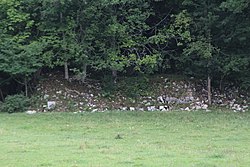Saint-Sulpice monastery
| Cistercian Abbey of Saint-Sulpice | |
|---|---|
 Remains of the former abbey |
|
| location |
Auvergne-Rhône-Alpes region Ain department |
| Coordinates: | 45 ° 53 '52 " N , 5 ° 35' 1" E |
| Serial number according to Janauschek |
65 |
| Patronage | St. Sulpicius II of Bourges |
| founding year | 1130 |
| Year of dissolution / annulment |
1791 ? |
| Mother monastery | Pontigny monastery |
| Primary Abbey | Pontigny monastery |
|
Daughter monasteries |
Monastery of Santa Maria di Falleri |
The Saint-Sulpice Monastery (Saint Sulpice en Bugey) is a former Cistercian abbey in France . It is located in the commune of Thézillieu in the Ain department of the Auvergne-Rhône-Alpes region , around 14 km northwest of Belley in the Bugey region .
history
The Cluniac priory in St-Sulpice-le-Vieux, founded at the beginning of the 12th century, was closed in 1130 according to the equipment of Count Amadeus III. of Savoy , the founder of the Hautecombe monastery , as a subsidiary of the Pontigny primary abbey to the Cistercian order. The monastery was soon moved to its later location and developed rapidly there. It founded the daughter monastery Chassagne in France in 1162 on a grangie built in 1145 as well as the daughter monasteries Santa Maria di Falleri and San Martino al Cimino in Italy (Latium) . Grangien of the monastery were built in Hostiaz and Prémilieu, Thézillieu, les Catagnolles, Lavant, le Genevray and Vaux-St-Sulpice, and wine cellars in Clairefontaine and Machuraz. In 1601 a stud farm was set up on the abbey grounds. At the beginning of the 18th century the abbey was renewed and the buildings were adapted to the tastes of the time. During the French Revolution , the abbey was dissolved and then used as a quarry. Only the former foreign band has survived. From 1968 to 1980 excavations took place, which reveal the plan of the complex.
buildings
The church was to the south, it had a long rectangular apse , which was flanked by two pentagonal side chapels. The nave had five bays , from the first bay a passage led to the north (left) located cloister , of which no remains have been preserved. In the northeast was a second, smaller cloister. There are also no remains of the Konversenbau . Parts of the surrounding wall are still standing.
literature
- Bernard Peugniez: Routier cistercien. Abbayes et sites. France, Belgique, Luxembourg, Suisse. Nouvelle édition augmentée. Éditions Gaud, Moisenay 2001, ISBN 2-84080-044-6 , p. 428.